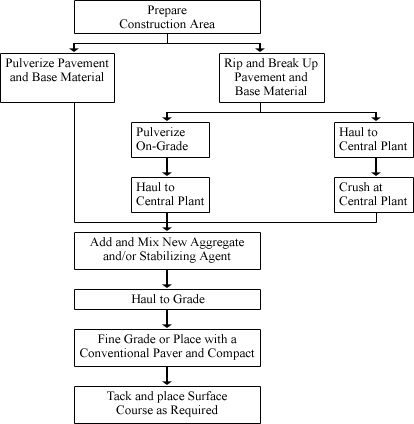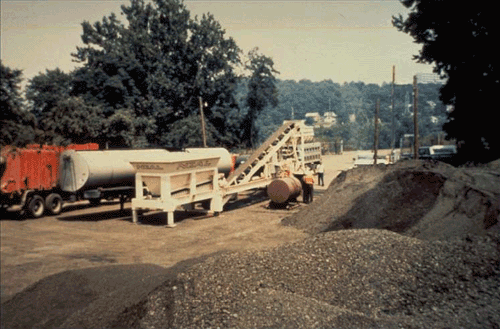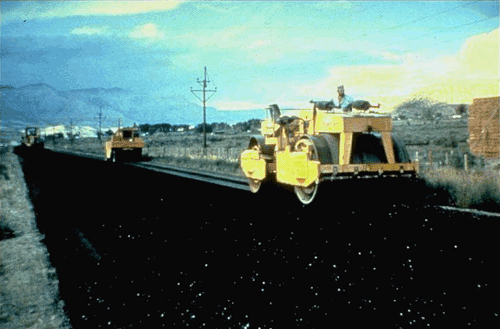ARCHIVED: Chapter 12. Cold-Mix Asphalt Recycling - Central Plant (Construction Methods And Equipment)
| << Previous | Contents | Next >> |
Introduction
Cold-mix asphalt recycling is defined as a process in which reclaimed asphalt pavement (RAP) materials are combined with new asphalt and/or recycling agents to produce cold base mixtures.(1) The term "cold-mix recycling" generally refers to central plant mixing and is done without application of heat. Central plant recycling is used for asphalt cold- mix recycling projects that require high rates of production or close control of the mix design.(1) Central plant recycling is used when stockpiles of RAP are available or when the existing pavement has to be removed off site for some reason and in-place recycling is not an option.
Cold-mix recycling has been used to correct pavement distress that involves both surface and base courses, although the method has been used mostly for base courses. One of the most popular methods is stabilization of cold recycled mixtures with emulsified asphalt. In addition to asphalt materials such as foamed asphalt cement, emulsion and cutbacks, the other types of additives include fly ash and portland cement.(2) Emulsified asphalts have also been used in combination with hydrated lime and portland cement. The important surface deficiencies that could be restored by cold mix recycling are reflection cracking and ride quality. The advantage of this process is that significant structural improvements can be made without altering the horizontal or vertical geometry of the pavement.(3) Roadway geometrics and structure can be improved and all crack types are fixed. Although acceptable performance has been achieved with cold central plant recycled mixes as surface courses, it is normally required that a surface treatment or a hot mix asphalt overlay be placed as a surface course. The surface course protects the recycled mix from moisture damage and abrasion by traffic. The different steps in cold-mix recycling in a central plant are shown in figure 12-1. The four main steps are:
- removal of the existing pavement,
- crushing and stockpiling,
- mixing, and
- laydown, aeration, and compaction.
Figure 12-1. Different steps in cold mix recycling.

A wearing surface should be applied after the completion of the cold mix recycling process.
Removal Of The Existing Pavement
The first step is to rip, scarify, pulverize or mill the existing pavement to a specified depth. The material is then hauled to a central plant, where it is crushed further, if required, stockpiled, and mixed with virgin asphalt binder and aggregate, if required, in a batch or drum-mix plant or a continuous (stabilization) plant. Removal of the existing pavement can be done in different ways.(2) However, it should be noted that recycled cold mix produced at a central plant from an existing RAP stockpile can be used for overlaying an existing pavement which does not have to be removed.
The first method is to rip the existing pavement material and load on grade. The material is then crushed and sized at the central plant. If the material is crushed entirely in the central plant, a better control can be achieved over the sizing of the RAP and reclaimed aggregates and hence oversizing can be avoided.
The second method consists of ripping, breaking, and pulverizing the in-place material before being hauled to a central plant for mixing. The important aspects of this method are that the method requires specialized equipment, considerable amount of traffic control and construction coordination efforts are needed, and since the sizing of the material is performed in-place, over sizing of RAP or reclaimed aggregate can occur.
The third option, which is very common, is to cold mill the pavement and haul the material to a central plant. This method provides a good control over the depth of pavement removal, and can achieve high production rate. However, the method may result in some aggregate oversizing.(2)
Crushing And Stockpiling
Crushing and screening plants are used to reduce the pieces of broken pavements to acceptable limits. The material is then stockpiled for immediate or future use. The height of the RAP stockpiles should be limited to prevent the crushed material from sticking together because of dead load and high temperature.(1) Construction equipments should not be permitted on the RAP stockpiles. To minimize sticking and excessive moisture in the stockpiles, the height of the stockpiles can be kept at a minimum by coordinating crushing and mixing operations.(1)
Mixing
Mixing may be done at a batch, drum, or continuous (stabilization) type of plant. A continuous type of plant is most often used for mixing.(1) Figure 12-2(1) shows the continuous type of mixing plant.
Figure 12-2. Continuous type cold-mix recycling plant.

The feed rates of the cold bins control the proportioning of the RAP and the new materials, since the screens are usually removed for cold-recycling operations in a batch plant.(3) Oversized material can be removed from individual bins by scalping screen or grizzly, and gradation of the combined materials should be checked periodically by taking samples from the belt. The plant should have the capability of accurately adding water (if needed) as well as the asphalt modifier to the recycled mix.
A twin-shaft pugmill is usually employed for mixing in a batch plant. Sized reclaimed asphalt pavement material, virgin aggregate, asphalt binder, and water, if needed, are proportioned by weight and fed into the pugmill. The batch is mixed and discharged into the haul truck before mixing another batch.(1)
Correct proportions of materials are maintained automatically by interlocked devices in a continuous mixing plant.(1) A positive displacement asphalt metering pump controls the automatic feeders, which in turn, measure and govern the flow of materials. Temperature corrections are needed to compensate for the volumetric changes in the materials. Some of these plants are now equipped with a belt scale to add asphalt emulsion and mixing water by weight. Also, sometimes the plant has a screening/crushing unit between the cold feed bins and pugmill to reduce oversized material from the stockpile. The plant may also have a storage silo or bin for the recycled mix which allows for a more continuous plant operation and facilitates truck loading. Emulsified asphalt mixes require shorter mixing time than HMA. There is a tendency to overmix emulsified asphalt base mixtures, resulting in scrubbing the emulsified asphalt from the coarse aggregate particles, and premature breaking of the emulsified asphalt, causing overly-stiff mixtures.(1) Undermixing can cause insufficient coating of the aggregates. The mixing time can be controlled in a continuous pugmill plant by changing the arrangement of the paddles, by varying the height of the end gate, or by changing the location of the asphalt spray bar. With a drum mix plant, mixing time is varied by varying the slope of the drum or by changing the location of the asphalt inlet pipe within the drum.
One hundred percent of coating of the coarse aggregate is not always achieved in the mixing plant, and it is not necessary to have 100 percent coating at the time of mixing.(1) Further coating takes place during spreading and rolling of the mix. Difficulty in coating particular types of aggregates should be evident in the mix design stage, and the mixing procedure should be adjusted to produce uniform dispersion of the emulsified asphalt with a complete coating of the finer aggregate fractions.(1)
Laydown, Aeration And Compaction
Aeration of the recycled mix is required to reduce the water and volatile content of the mix. The laydown and spreading equipment used for cold recycled materials is generally the same as for conventional hot mix asphalt.(2) The material can be placed in a windrow after mixing, after which it can be leveled to proper cross slope with a motor grader. The motor grader can also be used to aerate the mix by blading the mix back and forth across the roadway. This aeration process helps in reducing the fluid content of the mix so that it becomes stable enough to support the weight of the compaction roller. The rate of volatile loss is controlled primarily by the type of asphalt modifier, mix water content, gradation of the aggregate, wind velocity, ambient temperature, and humidity.
If the process of aeration can be avoided by accurately controlling the mixing moisture or due to climatic conditions the water evaporates without further manipulation of the mix, then conventional self-propelled pavers can be used to place the recycled asphalt cold-mix.(1) Towed types and Jersey spreaders attached to the front end of crawlers or rubber-tired tractors can also be used. Sufficient amount of fluid must be present in the mix to avoid tearing beneath the screed or strike-off bar. The screed should not be heated to avoid such a problem, as it makes the mix less workable by accelerating the drying process.(1) If the mix is too dry, the moisture content should be increased. The mixture should be placed uniformly over the pavement, beginning at the point farthest from the mixing plant. Hauling over freshly placed material should not be allowed except when required for completion of the work.
Dense-graded cold mixes should be placed in compacted thickness of 75 mm (3 in) or less, if practical, and with multiple lifts, some curing time should be allowed between successive lifts (two to five days under good curing conditions).(1) Open-graded cold recycled mixes can be placed up to thickness of about 100 mm (4 in). Construction should not continue during rainfall, or begin when rain is expected. The emulsified asphalt base should not be placed if the ambient temperature is below 10°C (50°F).(1)
Compaction can be done with static steel-wheel, pneumatic-tired and vibratory rollers, and combination of two or all three. Figure 12-3(2) shows a steel-wheel and a pneumatic-tired roller in combination for compacting cold recycled mixes. Very heavy pneumatic-tired rollers of 23 metric tons (25 short tons) or more are preferred for initial compaction (breakdown rolling) especially for thick lifts of 75 mm or more. Vibratory rollers are regularly used with the vibration normally at high frequency and a low amplitude. The factors controlling the number of passes required for compaction are properties of the mix, lift thickness, type and weight of roller, and environmental conditions.(4) Cold recycled mixes tend to be "fluffy" and therefore uncompacted thicknesses should be increased to achieve desired compacted thickness.(5,6) The moisture content is very critical to compaction of the mix. Sufficient moisture lubricates the particles and helps in compaction, whereas excess moisture causes low density and moisture retention in the sealed layers. After laydown, if it is found that additional curing is needed due to excessive moisture, then compaction should be postponed unless traffic disruption is a major problem.(2)
Figure 12-3. Steel and pneumatic - tired roller for compaction.

Usually a wearing course, in the form of HMA overlay or a double surface treatment is applied over the cold recycled asphalt base. The application of the overlay should be delayed for sufficient time if the mix needs additional curing to avoid moisture retention and loss of stability. During this delay, ideally, traffic should not be allowed on the surface. However, it is not always practical to delay the opening of traffic. Fog seal should be used if raveling becomes a problem.
Summary
Cold-mix recycling is performed by combining reclaimed asphalt pavement (RAP) materials with virgin asphalt and aggregate (if required) in a central mixing plant without the application of heat. Usually, this process is done for base course, and the asphalt cement is in emulsified form. This process can be used to rectify all types of cracks except fatigue cracks and those caused by base failures.
It can improve ride quality without altering the geometry of the pavement. It can be used to lower pavement profile by milling or removing a greater depth of pavement than that required for recycling. This allows pavement widening. The steps involved in the process consist of removal of the pavement to a specified depth, ripping in-place if desired, hauling the material to a central plant and further reduction in size by crushing, mixing with virgin materials, laydown, spreading, and compaction. Conventional pavers can be used for spreading cold recycled mix. However, the mix may require aeration before compaction to reduce the excess fluid content by evaporation. The moisture content of the mix must be carefully monitored during production to prevent excessive moisture which can cause stability problem, or insufficient moisture which can reduce workability. Although cold central plant recycled mixes can produce stable surfaces, a wearing surface over the recycled mix is normally required.
References
- Asphalt Cold-Mix Recycling, The Asphalt Institute Manual Series No. 20 (MS-20), Second Edition, 1986.
- Pavement Recycling Guidelines for Local Governments - Reference Manual, Report No. FHWA-TS-87-230, FHA, U.S. Department of Transportation, Washington, DC, 1987.
- J.A. Epps. State-of-The Art Cold Recycling, Transportation Research Record 780, Transportation Research Board, Washington, DC, 1980.
- J.A. Scherocman. Cold In-Place Recycling of Low-Volume Roads, Transportation Research Record 898, TRB, National Research Council, Washington, DC, 1983.
- R.G. Maag. Cold Recycling of K-96, Scott County, Kansas, AEMA Proceedings (Pavement Recycling with Asphalt Emulsions), Asphalt Emulsion Manufacturers Association, Washington, DC, 1982.
- A.J. Van Wijk, L.E. Wood, and P.E. Kercher. The Use of Asphalt Emulsions in Cold Recycled Asphalt Paving, AEMA Proceedings, (Pavement Recycling with Asphalt Emulsion), Asphalt Emulsion Manufacturers Association, Washington, DC, 1984.
| << Previous | Contents | Next >> |

